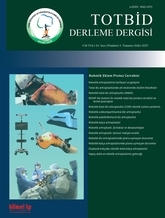
The development of technology is facilitating the rapid integration of artificial intelligence and robotic technologies into orthopedic surgery, resulting in more precise, safer, and individualized surgical procedures. In the domain of arthroplasty, the implementation of robotic surgical systems has markedly enhanced the precision of implant placement, expedited the postoperative recovery, and prolonged the durability of prostheses. The implementation of artificial intelligence algorithms in robotics has significantly enhanced their autonomous surgical capabilities, facilitated decision-making, and ensured procedural safety. Existing systems, like MAKO, ROSA, CORI, and Cuvis, provide diverse degrees of autonomy, surgical planning, navigation, and data processing functionalities. AI-assisted surgical systems enhance the surgeon`s intraoperative decision-making by providing features such as image identification, anatomical segmentation, haptic feedback, and real-time analysis. Furthermore, the utilization of augmented reality technologies enhances three-dimensional cognitive surgery, hence increasing surgical precision. We anticipate that robot-assisted arthroplasty operations, distinguished by personalization, autonomy, and diminished complication risks, will become normal treatment in the near future as these technologies gain prevalence.